| At 0330, Mr. Moewe was awakened begrudgingly, in order to prepare for the days mission. After patting his dog "Buck" goodbye, Moewe went to the Officer's Mess, deciding against the powdered eggs and settling for a cup of coffee for breakfast. By 0430, Moewe had made his way to the briefing room where the details of the days mission would be given to the pilots and navigators. The target of the day was the Memmingen Airfield. Moewe believed they would receive little opposition on what would be the 41st mission of his tour. Moewe noted that he felt it would be a "milk run." The crews assembled at their ships and began their pre-flight preparations. T/Sgt. Lafferty advised he didn't have any faith in "milk runs." Arriving at their ship, Moewe located S/Sgt. Burns sleeping near his ball turret. Moewe noticed that Burns appeared to be hung over from the previous nights celebration. Asking him if he was ok to fly, Burns smartly answered with only, "Yessir." The take-off and subsequent route to Germany was uneventful. Due to weather and a storm front in the area, Moewe's squadron and the 301st formation were 30 minutes behind schedule. A formation of P-51 Mustangs passed under the bombers and just as quickly disappeared, heading to an unknown destination. As they neared Innsbruck, the formation evaded some light flak and now found themselves 45 minutes behind schedule. A short time later, S/Sgt. Yarnell (gunner) yelled out "fighters." Moewe looked to his 3 o'clock and saw four Focke-Wulf 190 fighters heading toward his aircraft, 150 yards away. Moewe felt his aircraft quiver from the recoil of the numerous .50 caliber machine guns being fired toward the oncoming Focke-Wulfs. The sound of the machine guns was described as "terrific." At that same time, Moewe felt his ship buck as machine gun and 20mm cannon rounds from the Focke-Wulfs found their mark. The #1 and #2 engines of Moewe's aircraft immediately quit and the flap indicator on the instrument panel "spun like a top." Out of the corner of his eye, Moewe observed another B-17 as it began to spin, aflame and mortally stricken. Moewe saw 20mm cannon rounds exploding around the cockpit of the doomed B-17, as the Luftwaffe fighters continued their attack. Moewe then felt more machine gun and cannon rounds strike his ship. He again looked to his right and observed 15 Luftwaffe fighters, both Focke-Wulf 190s and Messerschmitt 109s again approaching from the 3 o'clock position. As smoke inside his aircraft continued to grow in intensity, Moewe knew that his ship was aflame. In preparation for the next attack by the fighters, Moewe pressed back into his seat, hoping to achieve as much protection as possible from his armoured seat. As he did this, a 20mm cannon round slammed into the cockpit. The explosion from the round pierced the left side window where 1st Lt. Haley was sitting. Shrapnel from the exploding round passed by Moewe, also destroying the window to the right of where Moewe was sitting. Despite the obvious danger of the situation, Moewe thought to himself with his usual humor, "That was close!" |
| H - Hour A Daily Record Kept by Lt. Parke W. Moewe while overseas March 7, 1944 Morrison Field, Fla. We are restricted here and I can’t write, telephone, or telegraph. Wish I knew you were home safely but then it does no good wishing. Had a physical exam today and then got a short haircut. Wish you could see me now, its ½ inch high. Then went swimming and had a steam bath. I’m trying to experience all the things that I can before leaving. Expect to leave tomorrow night 2:00AM. March 10 Sao Luiz, Brazil. Tried to land at Belem but it closed-in so went to alternate at Sasbring. There were 2 on our map and navigator started for the wrong one. Discovered mistake and barely made Sao L with 1hr fuel left! O’Fallen (Op off) and Dorsey made us welcome. Sao is really dirty. Venereal disease is 100% common. Women are very cheaply considered. Sent you stocking, album and bough famous Natal boots. Malaria bad here & naturally I had a mosquito lite. This is fine field. March 11 Portaligia, Brazil. Weather over Portaligia so stayed here. Rains often and little to do. Taking Atabrine religiously but suspect danger of malaria is overestimated. Brazilians seem very proud of their country and govt is doing best possible. Never the less poverty is very bad. Seem to be two classes, the Brazilian and the natives. Natives are most numerous and show German Portuguese, American, Negro and dutch blood. The women are anxious to bear white children and the soldiers, generally speaking, oblige. March 12 Fortalizio, Brazil. Uneventful trip but on arrival I landed – mediocre landing. Field boasts tents for sleeping quarters but they are comfy. Horseback riding here and I got a terrific sunburn. Really had fun riding, got pretty confident Saw natives as Phil Demuro and I rode along fence and they all want money. Naked children all over. Boys of 8yrs offered us their sisters for $1 at 7:00PM. Husbands sell wives for a night price of $0.50. Saw show – Ritz Brothers and really envied boys stationed here. March 13 Portaligia, Brazil. We leave tonight for Dakar at 10PM. Bought more stockings for you and tasted local beer and champagne (soda pop). It is sure lousy. Met Major Linn and Colonel (our C.).) Barton. Got bitten by a monkey and had it sterilized. Sunburn, malaria and babies. I’m worrying about them all but not seriously. Everything all set to go so am reading an Elerry Queen novel “Mystery of Greek Coffin” very good too. March 14 Rufisque, Africa. This is Dakar and a sorrier hole I never have seen. Malaria really bad. Latrines are of farm variety with fires burning in pits! Natives dress in sheets and all are black as coal. Their women are safe. Field is steel mat and poor, everything is piss pour. Am dead tired so am going to bed early. Food here is poor so ate little Those latrines though are the smokiest most filthy I ever saw. A B-17 ditched 2 ½ hrs from Portaliga – hope some were saved. March 15 Marakech, Africa. Good field here and fine facilities. Frenchmen everywhere and French planes too. Natives are real Arab types. Barracks are old French officer’s quarters and look like villas. Changed my money into gold seal money. B-26 crashed tonight. I saw it. Engine cut on takeoff and he came down through a wall. Pieces all over, 50cal ammo popping, flares exploding and a towering funeral pyre. One man thrown clear, horribly burnt, mumbling “mother” and “God”. Thought of you tonight. Expect I’ll see plenty of death soon. March 16 Tunis, Tunisia. After a trouble free trip we arrived at Tunis. Passed Bezerte on the way and saw sunken ships all over the harbor. Here at Tunis there are shell craters everywhere with grass growing in them now. Almost ½ mile away is Rommel’s former headquarters – nice too. We live in tents with straw floors. No lights, mattresses, water or toilet paper. Our first meal was a huge slab of Spam with jam and bread. Daniel has the GI’s and is pretty weak. Expect to move to new quarters nearer Tunis soon. March 17 Tunis, Tunisia. Daniel went to the hospital today and I guess he’ll be in for a few days. We flew from Oudna to Dedezeda, our home- to -be for a while. It has the same lack of comforts that the other place had. Our previous night was bitter cold so we hustled about today and got a stove made. It consists of a ½ drum, ¼ tube and a tank of gasoline. It works too. March 18 Tunis, Tunisia. Went into town today and it is certainly a strange place. Everywhere you look you see holes made by the Germans and allies during the battle a year ago. Some buildings look pretty bad. Visited the Ack-Ack club and met Bakar or “Buck” who is a true Arab. He dresses and talks like an American. He took us into the Kaspar, the Arabian walled city here. It is strictly dangerous as many have disappeared forever there. March 19 Tunis, Tunisia. More Ack-Ack clubbing tonight. There are many girls there but they are always the same ones. Obviously they can all be had for a sum of money but I love my wife far too much to be interested. Have our tent fixed up nice and cozy and your picture is right by my bed. Showed about 15 Arabs your picture in the Kaspar and they sure jabbered enthusiastically. March 20 Tunis, Tunisia. Buck took us to see a colonel in the Arabian Guards tonight. The king (Bey) is in the prison so the colonel was pretty bitter. The French have a strangle-hold on everything and they are very jealous of outsiders. They told the Arabs that in the States the Americans kill Arabs. Also that if they talk with us, after the Americans leave, they will be executed. What a mess. March 21 Tunis, Tunisia. Buck took us to a harem dance and it was sure “hot”. They wore their clothes but they sure made things interesting. Afterwards Buck took 2 home and I had a chance to see them closely. They are fatter than American girls and very conscious of their charms. Very likeable and intelligent. No darling, I didn’t even hold her hand. March 22 Tunis, Tunisia. Buck took us to the Colonel’s where we met an Arabian prince. He is from the royal blood that came over from Turkey 200yrs ago. He was also plenty angry at the French. We suggested he import American engineers to raise the country’s standards and he said he would. The big stumbling block to progress in this country are the French. They like the Germans and Americans. Germans were very polite and fair. March 23 Tunis, Tunisia. Had the GI’s today so did little. Fly tomorrow. Sure am missing you these days. Seems like our days together are like jewels as I look back. Hope I live to enjoy some more but I know that chances aren’t too good. The B-17 is a good plane but the opposition is plenty tough and losses are high on both sides. We won’t go on missions for another month anyway. March 24 Tunis, Tunisia. Pretty sick with the GI’s but flew anyway. We were complimented on our flying too. To heck with compliments, I’m more concerned from the standpoint of saving our necks. Sure wish I had a letter from you but must wait until we go to Italy. Sure miss you. March 25 Tunis, Tunisia. Didn’t fly today due to bad weather so got a horse and wagon and went riding. It was fun. We took a picture of a German graveyard. The dates were all of 1939. All around us can be seen evidence of battle although its been a year since there was fighting here. Shell holes, old German shells and cars are everywhere. We saw a huge salvage dump full of wrecked planes, cars etc. The war surely isn’t far away. March 26 Tunis, Tunisia. High winds and rain all day so we just sacked-up. Dan came back from the hospital and is feeling fine. We expect to leave for Italy in a couple of days. They say we will be pretty close to the lines. Boy! This pilot is going to dig a slit trench but quick. I’s anxious to go though because I’ll get mail and also the quicker we start the bombing the quicker I’ll see you again. March 27 We went into town to get our cleaning in preparation for going to Italy. Then we bought a few bottles of Cognac. I still am hoarding the Bourbon. Harley and Demuro stayed in town till midnight but Dan and I came home. I won’t be sorry to bid farewell to Tunis as it’s awfully dirty and even the field is devoid of anything like comfort. Expect to fly a practice mission tomorrow. Hope Jim feels ok. April 13 Foggia, Italy. Today we got up at 4;30AM on our first mission. By 9;00AM over the field, we started for the coast of Yugoslavia. There were 10 crews started for our squadron. We were part of a wing (240) and bombed Brode, Yugoslavia where there is a big marshaling yard. As we went over the coast, flak started coming up and some boys got holes through their wings. However we all got through, blasted the target and got home. No fighters. Don’t mind admitting I was pretty scared but after the flak, it wasn’t so bad. It was not knowing what to expect that was bad. May 6 San Servero. As we flew over the city, I couldn’t help wondering how many people we killed. Killing is so impersonal this way. It is so distant at 23,000ft. It’s well we don’t know the damage and agony we cause for we are not hardened warriors – just American boys who yesterday drank cokes in the local drugstore. May 24 Avisio , Italy. Today’s tilt with death was to Avisio bridge. We had an old ship and had to turn back short of the target by 20min, with a feathered engine. Although we did’t know it at the time, 9 German fighters attacked the formation a split second later. McSparron had two men killed and two men wounded in his crew. Yes, if we had been spotted by the Germans in our crippled condition, it would have been curtains. We are thanking God tonight. 14 missions, 13 sorties so far. June 22 Struck Formovo, Italy today. Marshaling yards and oil tanks with good results. No flak over target but on way back we hit flak near Bolognal and were severely shot up. One ship went down and exploded (5 chutes). One ship crashed in the Adriatic. On landing 3 ships cracked up due to flak damage. We got 2 holes, one through front. Heard of B-29s bombing Japan today. 21 missions and 18 sorties so far. July 4 Flew to Brasov, Romania where we hit an oil refinery. The flames went up to 5000ft and it was a satisfactory way of celebrating the 4th. Flak tended to be heavy but was inaccurate. An ME 109 hit #2 box but didn’t bother us. Sure am exhausted and am slated to fly tomorrow! Anyways I surely am getting them in fast. The whole thing has become a race to complete my 50. 33 sorties and 26 missions so far. July 5 Flew to Montpellier in France- a round trip of 1285 miles. Flak over the target was heavy but no fighters. We hit a RR yard there. The purpose of the day attacks is to keep 2 Divisions of Germans from reinforcing the 2nd front. Short of fuel so landed at Corsica. A bunch of Negro P-51 pilots landed there for fuel too. Two of them had wrecked ships so we brought them back to Italy with us. 34 sorties and 27 missions so far. July 7 (this is most vital target in Germany) Oil plant to Blechhammer Germany – really tough. A B-17 passed us near Wiernernewstandt with 6 ME-109s on its tail. We shot them up but the B-17 went down. Saw another go spinning down – 1 chute. We were attacked by a rocket plane but he missed. Two MEs mad a nose attack on my ship – the 20mm were bursting just over my head. My bombardier got 150 rounds into one of them. Flak over target heavy and we hit 2 other flak areas. 36 sorties and 28 missions so far. July 8 We hit Zwolfoxing which is a field at Vienna, Austria. It was by far the worst raid I’ve been on. The flak was unbelievably close and we dodged and wormed our way through. Frequently 3 or 4 shells would explode where we had been a moment before. Fighters hit us too. Ships all shot up – we only got 4 or 5 holes but one missed our gasoline tank and oil cooler by 1 inch. Lead ship – Captain Sieth, had a shell go through his wing but it was a dud and failed to explode!!! (no entries until July 15) the only missed entries in the entire H-hour record. July 15 (no more double mission credit except to Vienna or Germany). (39 sorties and 30 missions). Polesti again – we bombed by pathfinder. The results were amazing. A column of smoke 5 miles high which we could still see 200 miles away. The flak was extreme – they even had a few bursts of red flak. 3 fighters attacked our plane but we beat them off – shot up 700 rounds doing it. Saw a B-17 go down in flames. Lost 2 ships from 840 /squadron, one of them Capt Brooks, ten chutes were seen. Other ship crashed into the Adriatic – it went down at once – no survivors. All raids now are grim. The Germans are using their reserves – it is hell. This was the last entry…. With love to their father: James Allen Moewe and Richard Parke Moewe; Transcribed from the original diary April 2010 |
| While still flying at 23,000 feet, and having a difficult time keeping in formation, Moewe surveyed what he could see of his ship. The bomb bay area and the #2 engine were engulfed in flames and the smoke inside the aircraft continued to increase in intensity. As Haley and Moewe were unable to communicate with the rest of the crew due to damage to the comm system, Haley and Moewe put on their parachutes as they exited the cockpit with all of their restrictive flight gear still in place. The rest of the crew (with the exception of S/Sgt. Burns) was gathered around the escape hatch. After several very tense moment, Haley gave the order to bail from the stricken aircraft. Moewe noted the order in more appropriate and understandable terms, "Get the Hell out!" Moewe was the second man through the escape hatch. Diving head first through the hatch and into the slipstream, Moewe found himself tumbling through the air, then "fanny down" as he fell back to earth. He consciously thought to himself that he wanted to wait before opening his parachute, having heard stories of helpless airmen in chutes being strafed by enemy fighters. As Moewe continued to free fall, he experimented with various ways to control his body as he passed through the turbulent air at maximum velocity. One last look back at his aircraft saw "170" belching black smoke from the #2 engine, and the nose of the aircraft nosing back toward earth. As Moewe noted, it would be the last landing for "170." The sky remained full of parachutes, flaming debris, Focke-Wulfs and exploding shells. Looking over his shoulder, Moewe noticed the ground rushing up toward him, quite near, and decided to pull his ripcord. Immediately following the jerk of the parachute being deployed, Moewe found himself hugging the trunk of a tree! Waiting as he had, he was extremely close to the ground when he pulled the ripcord. His chute never fully opened but caught the top of a tree, the branches of which had slowed Moewe's fall back to earth. Catching in the top of the 50 foot tree, Moewe's parachute had saved his life. Climbing down to safety, Moewe remained still, hearing nearby German farmers working in the cultivated fields. He noted the sound of the Germans as being "menacing." Hiding in a wheat field, Moewe remained hidden until 2230 hours. Under the cover of darkness, Moewe followed a compass heading for Switzerland, which was approximately 65 km southwest from his present location. In near freezing temperatures, Moewe continued throughout the night, finding himself near a small town the next morning. He hid in some nearby woods, again waiting for nightfall to continue moving. During the day as he hid, a German civilian walked within 6 feet of him, failing to see the hidden airman. A large group of children appeared and began to play in the woods where Moewe was hiding. At approximately 1100 hours, the children discovered Moewe hiding in the woods, and quickly returned to the nearby town to warn others. A short time later, German soldiers captured Moewe in the wood, marching him back through the town. |

| Capt. Parke W. Moewe and Stalag Luft 1 817th BS(H), 483rd BG(H), 15th Air Force |

| I recently came into possession of a small grouping of items related to Parke W. Moewe who served as a B-17 pilot with the 817th Bomb Squadron (Heavy), 483rd Bomb Group (Heavy), of the 15th Air Force. This small grouping of items tells a fascinating story of a brave American aviator. Parke William Moewe was born on July 20, 1920 in Akron, Ohio. Moewe attended four years at Michigan State University with a major in economics (and later obtaining a law degree) before he began his military career with the United States Army Air Corps. Moewe entered the United States Army Air Corps as an aviation cadet on May 21, 1942, standing 5'10", 180 pounds with blonde hair and blue eyes. During his training he qualified with several firearms including the Thompson sub-machine gun, the 12 gauge shotgun and the Colt 1911 pistol. Moewe eventually made his way through the various stages of flight training, flying various aircraft including the PT-17, AT-6, BT-13, B-25, and eventually, the B-17 in various models. Moewe become a qualified multi-engine pilot and found himself assigned as a B-17 co-pilot with the 483rd Bomb Group. |
| On July 18, 1944, while on a bombing mission to an airfield near Memmingen, Germany, Moewe's flight of 26 B-17s were jumped by a large number of German fighters. Approximately 75 Focke-Wulf 190s attacked the formation of B-17s as they neared their target without fighter cover. Within the first five minutes, 14 B-17s were seen flaming down toward the ground, victims of the Luftwaffe fighters. After several devastating passes, Moewe found both of his left side engines and the radio room of his ship engulfed in flames. Once the "bail out" order had been given, Moewe and the rest of the crew made their way to the nearest exit and jumped from the slowly dying aircraft. (See the update below for Moewe's own detailed account of this incident.) |
| During his 10 month stay in Stalag Luft 1, Moewe used his specialized training to send coded messages back to the states relating to war crimes, underground factories and other military intelligence. Following the war, Moewe was informed that much of the coded information he and others like him had sent back had been useful, especially during the subsequent War Crimes Trials. Moewe described his time at Stalag Luft 1 as dull, boring and unpleasant. Many prisoners were shot without reason and the few Russian soldiers being held as prisoners were treated incredibly harsh by the Luftwaffe personnel. The prisoners in the camp were made up of officers from Britain, Russia, the United States and France, with the majority of the prisoners being American officers. Moewe and the other prisoners were given "Wartime Logs" by their German captors to record anything they wanted. The Germans later confiscated these journals in the hope of extracting intelligence from the entries. Moewe hid his "Wartime Log" and kept it with him, but this item was unfortunately missing from the grouping I obtained. (See update below!) On May 25th, 1945, Russian troops eventually overran Barth, freeing Moewe and his fellow prisoners from captivity. Moewe recalled seeing the dead bodies of a German mother, her older daughter and a small child still in a baby carriage, laying outside the front gates of the prison. Russian troops were raping and looting the entire town of Barth and many German women choose to end their lives than to be captured by the Russian soldiers. Following his release, Moewe was flown back to England in a B-17 and was airlifted to Reims, France. A Liberty freighter then brought Moewe back to the United States. Moewe and his wife, Betty Janes Anderson (Moewe) were reunited and spent two weeks recuperating in Miami Beach, Florida. Moewe ended the war having flown 41 missions with a total of 321 flight hours. He was awarded the Air Medal with three clusters, a Distinguished Unit Citation, the European-African-Middle Eastern Campaign Medal, the American Campaign Medal and the WWII Victory Medal. Despite having earned these awards, Moewe was only issued with his Air Medal before leaving the service. Moewe would experience a successful life as an attorney and a family man. He continued to serve his country in the United States Air Force Reserves following WWII. (The above information was obtained through various avenues of research and from an impromptu narrative found among Moewe's items entitled, "My Life in Peace and War" by Parke William Moewe, July 20, 1990.) |

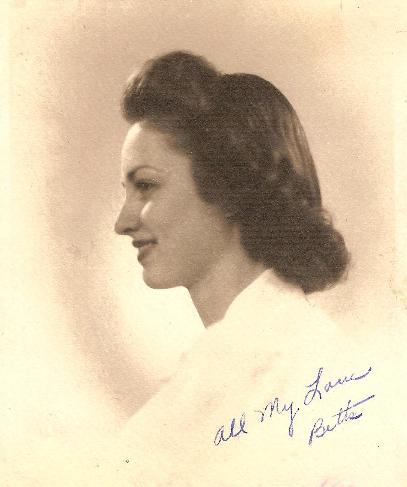

| Moewe climbed down from the tree and hid in some tall grass to wait for night fall. Traveling throughout the night, Moewe found himself on a forested hill on the outskirts of Kempton. Moewe was captured the following morning and held in the local jail until being transferred with other members from the raid to the very airfield they had targeted days earlier, Memmingen. Several days later, the Memmingen airfield was struck by another American air raid, causing the room Moewe was being housed in to be half destroyed by a bomb from the American bombers overhead. Moewe and the other prisoners were then trucked to the German interrogation center at Wetzlar, Germany where he was interrogated, without any kind of violence from the Luftwaffe interrogators. Moewe's interrogator failed to discover that he was one of few American aviators who had received specialized training a month earlier in the use of codes and espionage, to be utilized in the event of capture. Moewe's orders with his specialized training was to report the Senior U.S. Officer in the prisoner of war camp if he were to be captured. While at Wetzlar, Moewe sought out the senior most officer who was an Air Corps Colonel. Moewe thought something about the Colonel was odd and suspicious, so he elected to not reveal his specialized training at that time. Later, after arriving at his permanent prisoner of war camp at Stalag Luft 1 in Barth, Germany, Moewe contacted the Senior American officer and revealed the training he had received. He also later learned that the suspicious American Colonel he had encountered at Wetzlar was in fact a German imposter, who had been placed among the prisoners of war to identify prisoners such as Moewe who had this specialized training. |




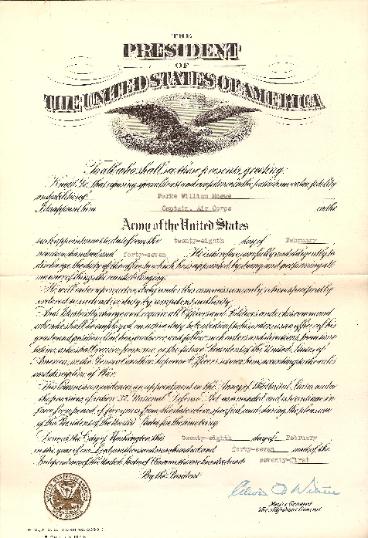

| A post-war photograph showing Capt. Parke Moewe and family, with Moewe wearing his United States Air Force uniform. Given the United States Air Force uniform in the photograph, this photo was taken after 1947. |
| Moewe's promotion documents for the ranks of First Lieutenant and Captain. |
| Relics of a vanquished enemy: Two Luftwaffe related items brought back from the war by Moewe. A Luftwaffe enlisted mans cap missing its visor but retaining its original Eagle device and brocade. The interior of the cap identified the original German owner with the last name of "Paduch." Also shown is the remnants of a pair of Luftwaffe model 295 goggles, dated 1940. Given Moewe's position as a prisoner of war in Stalag Luft 1, it seems reasonable to assume that Moewe obtained these items from his former captors at Stalag Luft 1 following his release. |
A post-war photograph showing Moewe and other United States Air Force personnel in
formation, and Moewe's United States Air Force visor cap.
formation, and Moewe's United States Air Force visor cap.

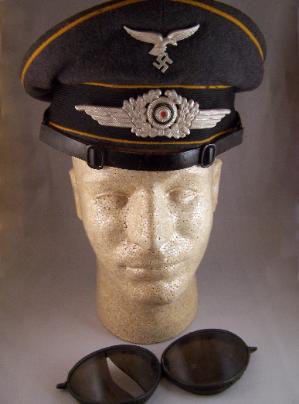


| Two Army Air Corps D-4 flight computers from Moewe's career, each showing minor wear and use. Also pictured is an original 15th Air Force shoulder patch and Moewe's WWII Air Medal. |
| This page is dedicated to Capt. Parke William Moewe, the members of his crew, the members of the 15th Air Force and the former captives at Stalag Luft 1. If anyone has any additional information or items related to Capt. Moewe or any of the crewmen on this aircraft, please feel free to contact me at webmaster@danielsww2.com. I am interested in adding photographs of the other 9 crewmen of this aircraft to put faces with the names. |
| The C.E. Daniel Collection |
The Crash Report:
| The United States Army Air Corps crash report shed a tremendous amount of light on the downing of Moewe's aircraft. Unlike most crash reports involving the accidental crash of a military aircraft during non-combat conditions, the crash report provided additional information which could not have been obtained otherwise, relating to that fateful day. It also provided additional information about the other men who were part of the aircraft's crew during that last mission. The information contained within the crash report was compiled following detailed interviews with the other crew members, following their repatriation from German prisoner of war camps at the end of the war. As always, credit for obtaining the crash report goes to www.accident-report.com. They provided a professional and efficient service in helping to obtain copies of these crash reports for any interested parties. |
|
| Moewe's aircraft was identified in the crash report as B-17G, serial number 42-107170. The four engines of the B-17G were identified as having the following serial numbers: 42-013195, 42-622290, SW-012891 and SW-013290. The Browning .50 machine guns assigned to the aircraft on the day of this mission were identified by the following serial numbers: 1191986, 1296061, 1191984, 159186, 1191470, 1192476, 1191781, 1192140, 1192575, 1192040, 1192501, 1182296, 1296254. Witnesses interviewed relating to the downing of Moewe's B-17G were listed as: 1) Lt. Col. Williard S. Sperry who indicated that Moewe's flight was intercepted by approximately 150 German fighter aircraft. Attacks by the German fighters were made with 5 to 6 Germa fighters at a time, with the fighter aircraft described as attacking in a "javelin" formation, coming in at the same altitude as the bombers and firing at the rearmost B-17 in each formation. The fire power of the attacking German fighters was described as "overwhelming." 2) 2nd Lt. Frederick M. Orringer (Navigator) who recalled seeing Moewe's aircraft flying on the right wing of the B-17 he was in. Moewe's aircraft was observed peeling off to the left, crossing in front of Orringer's aircraft. Orringer descirbed the wings of Moewe's aircraft as being "black" and the right wing was on fire. Orringer did not see any crewmen or parachutes exiting from Moewe's aircraft before losing site of it as it went down. |
One Casualty - S/Sgt. Jack C. Burns:
| All crew members of Moewe's aircraft bailed from the stricken aircraft, surviving the incident and later becoming prisoners of war, with the exception of S/Sgt. Jack C. Burns. Interviews from the surviving crew members following the end of the war, indicate that S/Sgt. Jack C. Burns was most likely killed when a 20mm cannon round fired by an attacking German fighter penetrated the ball turret where Burns was positioned as a gunner. The strike on the ball turret occurred during one of the first waves of fighter attacks experienced by the aircrew, and several crewmen recall that Burns ball turret fell silent, and he was not heard firing his machine guns as the attacks continued. All of the surviving crewmen indicated that it was their belief that Burns was killed during this initial attack, and that he went down with the aircraft. The location of the crash of the aircraft was described as being somewhere between Kempden and Memmingen, Germany. German documents included in the crash report indicate that the body of Burns was recovered the following day at the crash site, and his remains were buried at Seibranz cemetery. |
Update: April 2010
| Within the last few weeks, I was very fortunate to have been contacted by both of Mr. Moewe's sons. It was with great pleasure that I was able to speak to each of them and learn more about this patriotic aviator, his character and personality, and his dedication as a family man. Everything I learned about Mr. Moewe from his sons lived up to my expectation of what I had already learned about him, and what I believed him to be, having simply researched a brief period of his life. His legacy is one of a driven, determined individual who found humor in all aspects of life, yet he maintained a focus which allowed him to achieve terrific goals and success throughout his lifetime. I was also greeted with the astonishing news that Mr. Moewe's Wartime Log still existed. Mr. Moewe's Wartime Log was generously sent to me for examination and additional research. With no other way to explain it, I sat at my desk like a small boy opening a new toy. I sat for hours the first night the Wartime Log arrived, reading each page with excitement, historical curiosity and reverence. To a preserver of history, Mr. Moewe's Wartime Log was a treasure trove of information. To someone who was getting to know Mr. Moewe through his wartime artifacts, it was a rare glimpse into the life of an extraordinary man. The log contained a detailed description of the day Mr. Moewe and his crew were shot down, from breakfast to capture. It contained poetry, drawings, detailed observations of various aspects of the war, and details about the captivity of the POWs in Stalag Luft 1. The vast amount of information which is contained in the log could not adequately be detailed here on one page. Still, there are some aspects of the log which are vital in telling Mr. Moewe's story about his military career and his time in Stalag Luft 1. Below is a synopsis of the details of the last mission flown by Mr. Moewe and his crew. The details were taken from the opening pages of Mr. Moewe's wartime log, which he compiled within weeks of his capture, and while he was held captive in Stalag Luft 1. |
| July 18, 1944 - The Last Mission of "170" |

Focke-Wulf 190 A-8

An early photograph of Moewe proudly standing in front of his ship.
| Moewe noted that the German civilians of the town seemed curious, with one older male waving his fist at Moewe. Locked in the town jailhouse, Moewe found the German soldiers to be friendly, even procuring from them a stein of beer. Later, hearing familiar voices, Moewe realized that several of the crewmen from his ship and a few other airmen from others ships were also being held in the same jailhouse. Moewe and the rest of the airmen would be moved to Memmingen the following morning and confined at the very location they had intended to bomb on their last mission. The area showed the devestation of past missions. During their confinement at Memmingen, Moewe would nearly be killed by American bombers which continued to bomb the airfield and surrounding areas. The captured airmen would go without food or water for more than a day, before being supplied with ersatz coffee and black German bread. Seeing the condition of the hungry captives, one German guard even shared his meal with the captured airmen. Days later, Moewe and the other airmen would travel by train to Oberusal for interrogation. Their train passed through the remnants of Frankfurt which Moewe noted as being "totally destroyed." Kept in solitary for four days before being questioned. Refusing to answer any questions, Moewe was placed back into his cell. Later, he would discover that the Luftwaffe interrogator knew more about his bomb squadron than he did. Moewe and the others would be transferred to Wetzlar where they would spend two days before being sent to Stalag Luft 1, Barth, Germany. It was at Stalag Luft 1 that Moewe would be given his Wartime Log from the American Red Cross, via the German Luftwaffe. |
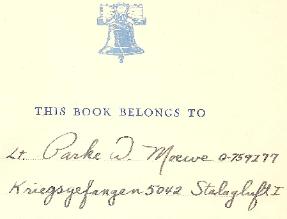
| Moewe would find life in Stalag Luft 1 to be boring and dull. The men maintained the military discipline of rank and the Germans maintained a ritualized schedule for the prisoners, continuously counting the captives to ensure all were present. Moewe would pass the time thinking of his wife, home, and future plans. He made numerous drawings in his log of the camp and its surroundings, and recorded poetry on a few pages. He collected his thoughts of his experiences, his observations of Germany and its people, and even the plight of the German civilians in a wartime setting. He made note of his elation at FDR being re-elected as President, and his sadness at FDR's passing. Moewe found Germany to be clean and orderly. The people were "decent, quiet folk, their homes and stores emitting an air of solidity and the ever present cleanliness." He recorded his impressions of Luftwaffe pilots who he saw as "cocky" as they "seemed to like to throw their rank around" adding that he had never seen "so much heel clicking." But he also remembered the Luftwaffe pilots as being brave men who would press their attacks at the expense of their own safety. |
| On April 30th, 1945, Moewe and the others would find Stalag Luft 1 empty of all the German guards. A nearby airfield and Flak school were destroyed by the retreating Germans. A famed American Ace, Col. Hubert A. "Hub" Zemke would order the airmen to begin digging slit trenches as the nearby explosions rocked the prison compound. With plenty of food and water, the former captives remained in good spirits, awaiting the arrival of the Russians for liberation. Col. Henry Russell Spicer, freed from solitary confinement where he had been sentenced to death 5 months earlier, emerged into the courtyard with a Luger strapped to each leg, looking for Germans. On May 1, 1945, the former captives were listening to The Lucky Strike Hit Parade on the BBC. At approximately 2230 hours, the BBC announced that Hitler was dead. The camp went wild. The BBC returned to its programming, playing the #1 song at the time, oddly enough the song was "Don't Fence Me In." For the first time that evening, the Star Spangled Banner was played over the public address system from London. Everyone stood at attention and some simply cried. Moewe described this moment as a "very real touching moment." One could only imagine the sense of pride and relief the one song brought to so many after many months, and in some cases years of captivity. As with the other residents of the camp, Moewe would eventually be evacuated by air and spirited away from the hell he once called home, Stalag Luft 1. Moewe's Wartime Log contained many other entries, with so much information it could not be contained on one simple page. The log stands as a testimonial to ever observant mind of a man who undoubtedly had to worry about what his future would hold. Also found inside the log were various forms of currency, mementos from his time in camp and several short letters written by him to his wife Betty. |



Drawings by Parke W. Moewe during his confinement at Stalag Luft 1.


Wartime correspondence from Moewe to his wife Betty, dated August 22, 1944, written from inside Stalag Luft 1.




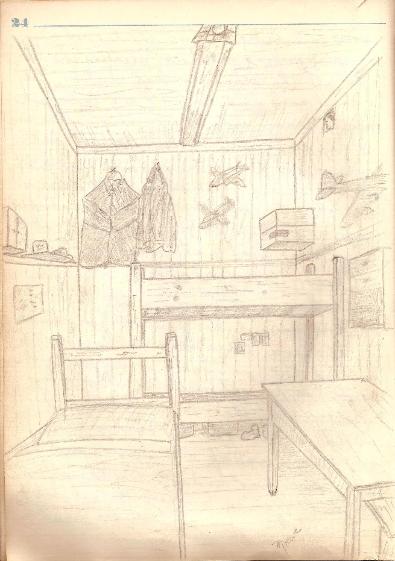
| Above, numerous drawings as recorded by Moewe in his Wartime Log. |
| A photograph of Parke and Betty Moewe, taken in September of 1987. The photograph was taken during a reunion of the 483rd Bomb Group in Boston Massachusetts. |
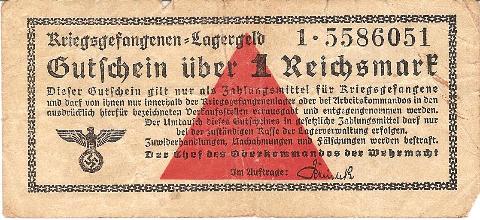
| Moewe's Diary Below are excerpts from Moewe's diary. These details were provided by his son, for inclusion on this page. |
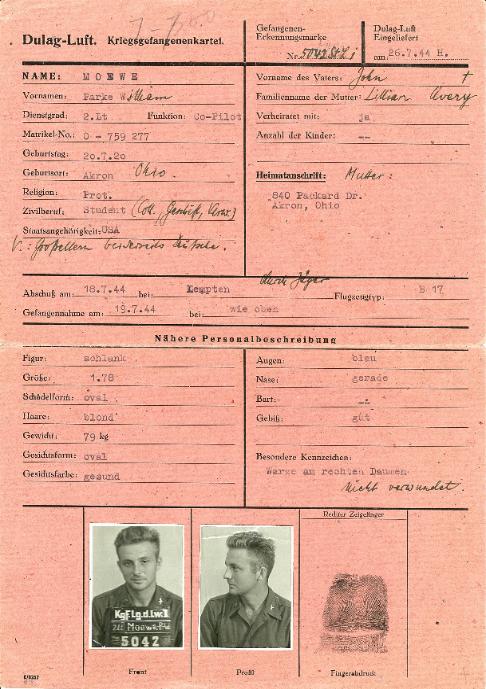

| The original Stalag Luft 1 dosier for Parke Moewe, as provided by his son. |



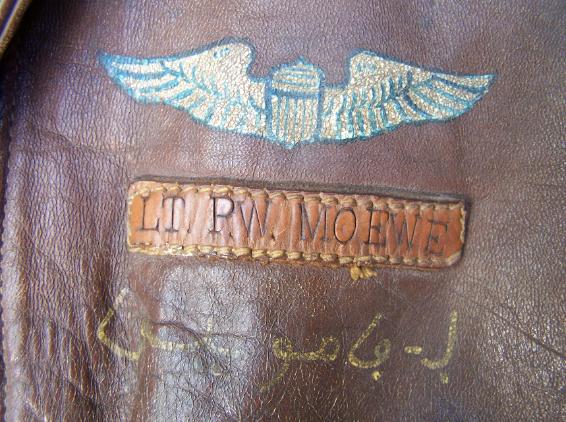
| Above, several photographs showing details of Capt. Parke William Moewe's painted A-2 flight jacket that he wore during the war. The back of the jacket shows yellow bombs, one painted for each mission he completed and a red bomb with a parachutist for his 41st and final mission. The front of the jacket shows Moewe's leather name tag, hand painted wings and Arabic writing. The A-2 is a cherished part of my private collection and is NOT for sale. I am honored to have the opportunity to care for and preserve this item for Capt. Moewe. 8/2010 |
| Moewe's Missions: |
| The following as a partial listing of missions in which Mr. Moewe participated in during his combat career: 1944 Date Target Pilot Assignment April 13th Brode Haley FP/Moewe CP April 15th Nis Haley FP/Moewe CP April 17th Belgrade Haley FP/Moewe CP April 23rd Wiener Neustadt Haley FP/Moewe CP April 30th Milan Nivens FP/Moewe CP May 5th Turnull Severin Haley FP/Moewe CP May 6th Turnull Severin Haley FP/Moewe CP May12th Massa d'Albe Haley FP/Moewe CP May 13th Bolzano Haley FP/Moewe CP May14th Ferrara Haley FP/Moewe CP May 19th Casarsa Haley FP/Moewe CP May 23rd Avezzano Haley FP/Moewe CP May 24th Avisio R.R. Viaduct Haley FP/Moewe CP May 25th Lyon/Venissieux Haley FP/Moewe CP May 26th St. Etienne Haley FP/Moewe CP June 13th Munich/Oberpfaff. Haley FP/Moewe CP June 16th Vienna/Florisdorf Haley FP/Moewe CP June 22nd Fornova di Taro Moewe FP/Huisman CP June 23rd Polesti Haley FP/Moewe CP June 25th Sete Haley FP/Moewe CP June 26th Vienna Moewe FP/ ? CP (Veteto top turret) June 27th Brod Moewe FP/ ? CP (Haley crew) June 30th Blechhammer Haley FP/Moewe CP July 2nd Almasfuzito Haley FP/Moewe CP July 3rd Piatra Moewe FP/Odell CP July 4th Brasov Haley FP/Moewe CP July 5th Montpellier Haley FP/Moewe CP July 7th Blechhammer Haley FP/Moewe CP July 8th Vienna/Zwolfoxing Haley FP/Moewe CP July 15th Polesti Haley FP/Moewe CP July 18th Memmingen Haley FP/Moewe CP |
Update: June 2013
| On June 15,2013, I received an email from a Bavarian aviation archaeologist, Ludwig Hauber, who had located the Haley/Moewe B-17 crash site. Hauber and the Moewe family were brought together and over the next few months, arrangements were made to send pieces from the crashed B-17 to the Moewe family. I am very honored to have received several pieces of this aircraft from the Moewe family, to be displayed along with Mr. Moewe's other items. A heat treatment stamp can be found on two of the aircraft pieces, one reading HT51 and another reading HT71. (See photos below for additional detail.) Accompanying the aircraft pieces that were delivered to the Moewe family was a letter from Hauber, which read as follows: Badtolz, Bavaria 6th of August 2013 Dear Family Moewe, The first parts of the B17 Haley Crew were found in 2006. I had exchanged 2 emails with Carl Weinknecht, but unfortunately he has also passed away. I found the parts that are included with this letter in the Fall of 2012 and June of 2013, most are from the wing and cockpit. I will send a detailed description via email. I guarantee 100% that these airplane parts are the original parts from the B17 plane that was flown by your father and that they were found at the original location. The location is far from Menningen in the southwest. I enjoy your emails (photos) very much and I will respond as soon as we are further along with the book. Best Wishes, Ludwig Hauber, Bavaria Mr. Hauber and another aviation researcher are in the process of writing a book detailing the events of the day that the Haley/Moewe B-17 was lost in combat. Details on the book will follow once it is published. |

| The three pieces of the Haley/Moewe B-17, recovered from its crash site, and kindly given to me by the Moewe family. The bottom portion appears to be the lower edge of a side cockpit window. The top piece, appearing to be from a section of wing, has two different heat treatment stamps on each side. See below for close up detail of one of the stamps, "HT72." |
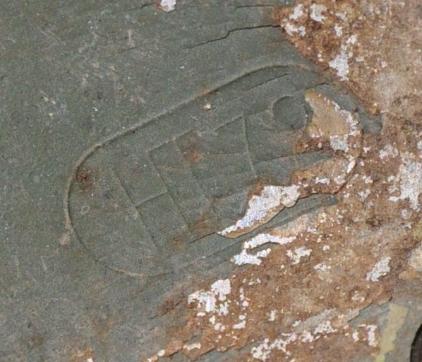



| A photograph showing the type of terrain where the Haley/Moewe B-17 was located and from where the above aircraft parts were recovered. A special thank you to Ludwig Hauber for sharing this photo and for the work of all the men involved in preserving this history. |

| 3-8-14 A newly added photograph of Capt. Moewe and his crew. The crew shown are identified as follows: Top Row (l to r) J.J. Blanchard, C.H. Dreps, R.S. Yarnell, C.W. Kleinknecht, and V.J. Rosczewski Bottom Row (l to r) P.W. Moewe, E.J. Lafferty, J.C. Burns, J.R. Haley, D.J. Lionette. The above photo is believed to have been taken in May or June of 1944. During this time period, the crew would most likely have still been stationed in Sterparone, Italy. |
